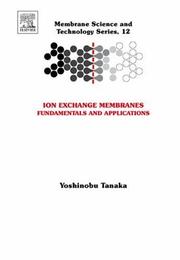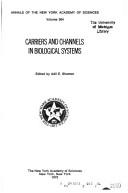| Listing 1 - 10 of 16 | << page >> |
Sort by
|

ISBN: 1281119806 9786611119805 0080548644 0444519823 9780444519825 9780080548647 Year: 2007 Publisher: Amsterdam ; Oxford : Elsevier,
Abstract | Keywords | Export | Availability | Bookmark
 Loading...
Loading...Choose an application
- Reference Manager
- EndNote
- RefWorks (Direct export to RefWorks)
Fundamental study and industrial application of ion exchange membranes started over half a century ago. Through the ongoing research and development, the ion exchange membrane technology is now applied to many fields and contributes to the improvement of our standard of living. Ion Exchange Membranes states the ion exchange membrane technology from the standpoint of fundamentals and applications. Discussing not only various phenomena exhibited by the membranes but also their applications in many fields with economical evaluations.* This volume looks at the latest developments
Ion-permeable membranes. --- Membranes (Technology) --- Artificial membranes --- Separation (Technology) --- Technology --- Ion exchange membranes --- Permeable membranes (Electrodialysis) --- Permselective membranes --- Electrodes, Ion selective --- Electrodialysis --- Ion exchange
Book
ISBN: 0444663215 0444633197 9780444663214 9780444633194 Year: 2015 Publisher: Amsterdam, Netherlands : Elsevier,
Abstract | Keywords | Export | Availability | Bookmark
 Loading...
Loading...Choose an application
- Reference Manager
- EndNote
- RefWorks (Direct export to RefWorks)
Fundamental study and industrial application of ion exchange membranes started over half a century ago. Through ongoing research and development, ion exchange membrane technology is now applied to many fields and contributes to the improvement of our standard of living. Ion Exchange Membranes, 2nd edition states the ion exchange membrane technology from the standpoint of fundamentals and applications. It discusses not only various phenomena exhibited by membranes but also their applications in many fields with economical evaluations. This second edition is updated and revised, featur
Ion-permeable membranes -- Research. --- Ion-permeable membranes -- Testing. --- Chemistry --- Physical Sciences & Mathematics --- Physical & Theoretical Chemistry --- Ion-permeable membranes --- Testing. --- Research. --- Ion exchange membranes --- Permeable membranes (Electrodialysis) --- Permselective membranes --- Electrodes, Ion selective --- Electrodialysis --- Ion exchange --- Membranes (Technology)
Book
ISBN: 1634842006 9781634842006 9781634841993 1634841999 Year: 2016 Publisher: New York
Abstract | Keywords | Export | Availability | Bookmark
 Loading...
Loading...Choose an application
- Reference Manager
- EndNote
- RefWorks (Direct export to RefWorks)
Membranes (Technology) --- Ion-permeable membranes. --- Ionomers. --- Fluoropolymers. --- Copolymers. --- Polymers --- Fluorinated polymers --- Fluorine plastics --- Fluorocarbon polymers --- Fluoroplastics --- Organofluorine compounds --- Ion exchange membranes --- Permeable membranes (Electrodialysis) --- Permselective membranes --- Electrodes, Ion selective --- Electrodialysis --- Ion exchange --- Artificial membranes --- Separation (Technology) --- Technology

ISBN: 044450236X 9786611756185 1281756180 0080509401 9780444502360 9780080509402 Year: 2004 Publisher: Amsterdam ; Boston : Elsevier,
Abstract | Keywords | Export | Availability | Bookmark
 Loading...
Loading...Choose an application
- Reference Manager
- EndNote
- RefWorks (Direct export to RefWorks)
Today, membranes and membrane processes are used as efficient tools for the separation of liquid mixtures or gases in the chemical and biomedical industry, in water desalination and wastewater purification. Despite the fact that various membrane processes, like reverse osmosis, are described in great detail in a number of books, processes involving ion-exchange membranes are only described in a fragmented way in scientific journals and patents; even though large industrial applications, like electrodialysis, have been around for over half a century. Therefore, this book is emphasizing
Membrane separation. --- Ion-permeable membranes. --- Membrane separation --- Membranes échangeuses d'ions --- elektrodialyse --- ionuitwisselingsmembraan --- membraanfiltratie --- scheidingstechniek --- Membranes échangeuses d'ions --- Electrodialysis --- Ion-permeable membranes --- Filtration, Membrane --- Membrane filtration --- Separation, Membrane --- Separation (Technology) --- Ion exchange membranes --- Permeable membranes (Electrodialysis) --- Permselective membranes --- Electrodes, Ion selective --- Ion exchange --- Membranes (Technology) --- Dialysis --- Industrial applications --- Electrodialysis. --- Industrial applications.
Book
ISBN: 2222020212 9782222020219 Year: 1977 Volume: 258 Publisher: Paris: CNRS,
Abstract | Keywords | Export | Availability | Bookmark
 Loading...
Loading...Choose an application
- Reference Manager
- EndNote
- RefWorks (Direct export to RefWorks)
Ion-permeable membranes --- Plant translocation --- Plant membranes --- Congresses --- -Plant membranes --- -Plant translocation --- -Plants --- Translocation (Botany) --- Translocation in plants --- Biological transport --- Plants --- Plants, Motion of fluids in --- Membranes (Biology) --- Plant cells and tissues --- Ion exchange membranes --- Permeable membranes (Electrodialysis) --- Permselective membranes --- Electrodes, Ion selective --- Electrodialysis --- Ion exchange --- Membranes (Technology) --- Translocation --- Assimilation --- Metabolism --- -Congresses --- Ion-permeable membranes - Congresses --- Plant translocation - Congresses --- Plant membranes - Congresses

ISBN: 0120781425 9786610630448 1280630442 0080455417 9780080455419 9780120781423 Year: 2005 Publisher: Amsterdam London Elsevier Academic
Abstract | Keywords | Export | Availability | Bookmark
 Loading...
Loading...Choose an application
- Reference Manager
- EndNote
- RefWorks (Direct export to RefWorks)
Fuel cells are electrochemical energy conversion devices that convert hydrogen and oxygen into water, producing electricity and heat in the process and providing fuel efficiency and reductions in pollutants. Demand for this technology is growing rapidly. Fuel cells are being commercialized for stationary and portable electricity generation, and as a replacement for internal combustion engines in automobiles. Proton Exchange Membrane (PEM) fuel cells in particular are experiencing an upsurge. They have high power density and can vary their output quickly to meet shifts in power demand.
Fuel cells. --- Ion-permeable membranes. --- Piles à combustible --- Membranes échangeuses d'ions --- Ion exchange membranes --- Permeable membranes (Electrodialysis) --- Permselective membranes --- Electrodes, Ion selective --- Electrodialysis --- Ion exchange --- Membranes (Technology) --- Direct energy conversion --- Electric batteries --- Electric power production from chemical action --- Electrochemistry
Book
ISBN: 012398372X 0123877105 9780123877109 Year: 2013 Publisher: Amsterdam ; Boston : Elsevier/Academic Press,
Abstract | Keywords | Export | Availability | Bookmark
 Loading...
Loading...Choose an application
- Reference Manager
- EndNote
- RefWorks (Direct export to RefWorks)
Demand for fuel cell technology is growing rapidly. Fuel cells are being commercialized to provide power to buildings like hospitals and schools, to replace batteries in portable electronic devices, and as replacements for internal combustion engines in vehicles. PEM (Proton Exchange Membrane) fuel cells are lighter, smaller, and more efficient than other types of fuel cell. As a result, over 80% of fuel cells being produced today are PEM cells. This new edition of Dr. Barbir's groundbreaking book still lays the groundwork for engineers, technicians and students better than any other
Proton exchange membrane fuel cells. --- Ion-permeable membranes. --- Fuel cells. --- Sustainable Development --- Environmental Sciences --- Direct energy conversion --- Electric batteries --- Electric power production from chemical action --- Electrochemistry --- Ion exchange membranes --- Permeable membranes (Electrodialysis) --- Permselective membranes --- Electrodes, Ion selective --- Electrodialysis --- Ion exchange --- Membranes (Technology) --- PEFCs (Fuel cells) --- PEM fuel cells --- PEMFCs (Fuel cells) --- Polymer electrolyte fuel cells --- Polymer electrolyte membrane fuel cells --- Proton conducting membrane fuel cells --- Fuel cells

ISBN: 0890720185 9780890720189 Year: 1975 Volume: 264 Publisher: New York (N.Y.): New York Academy of Sciences,
Abstract | Keywords | Export | Availability | Bookmark
 Loading...
Loading...Choose an application
- Reference Manager
- EndNote
- RefWorks (Direct export to RefWorks)
Biological Transport --- Cell Membrane Permeability --- Bilayer lipid membranes --- -Biological transport --- -Ion-permeable membranes --- -Membranes (Biology) --- -Ion exchange membranes --- Permeable membranes (Electrodialysis) --- Permselective membranes --- Electrodes, Ion selective --- Electrodialysis --- Ion exchange --- Membranes (Technology) --- Permeability, Cell Membrane --- Ionophores --- Membrane transport --- Passive transport, Biological --- Physiological transport --- Transport, Biological --- Diffusion --- Osmosis --- Bilayer phospholipid membranes --- Bimolecular lipid membranes --- Black lipid membranes --- BLMs (Membranes) --- Lipid bilayer membranes --- Lipid bilayers --- Lipid bimolecular membranes --- Phospholipid bilayers --- Biological models --- Cell membranes --- Lipid membranes --- Biologic Transport --- Transport, Biologic --- Transport Vesicles --- Membrane Transport Proteins --- Congresses --- Biological transport --- Membranes (Biology) --- Ion-permeable membranes --- Biomembranes
Book
Year: 2022 Publisher: Basel MDPI - Multidisciplinary Digital Publishing Institute
Abstract | Keywords | Export | Availability | Bookmark
 Loading...
Loading...Choose an application
- Reference Manager
- EndNote
- RefWorks (Direct export to RefWorks)
Bacterial nanocellulose (BNC), cellulose nanocrystals (CNCs), and cellulose nanofibers (CNFs) are three nanometric forms of the most abundant natural polymer (viz. cellulose), and are currently under the spotlight in numerous fields of modern science and technology. The eco-friendly connotations, peculiar features, and multiple functionalities of these nanoscale cellulosic substrates are being explored to engineer advanced nanocomposites and nanohybrid materials for application in manifold domains, such as mechanics, optics, electronics, energy, environment, biology, and medicine.The aim of this Special Issue titled “Advanced Nanocellulose-Based Materials: Production, Properties, and Applications” is to gather original research and review contributions from the world-leading scientists working with nanocellulose. Thus, research that is representative of the current developments dealing with the production methodologies, properties, and applications of nanocellulose-based materials (e.g., nanocomposites, hybrids, aerogels, hydrogels, films, and fibers) are presented in the Special Issue.
Technology: general issues --- bacterial nanocellulose --- lignosulfonates --- mechanical performance --- thermal-oxidative stability --- ion-exchange membranes --- biobased separators --- ionic conductivity --- oxidized bacterial cellulose --- chitosan --- alginate --- layer-by-layer assembly --- multi-layered patches --- dexpanthenol --- wound healing --- cellulose nanocomposite --- ice-templating --- interface --- orientation --- mechanical properties --- cellulose nanofibrils --- wood --- lignin --- TEMPO-oxidation --- cellulose nanomaterials --- nanoscale resolution --- cellulose --- chitosan nanoparticles --- bionanocomposites --- 5-fluorouracil --- in vitro drug release --- cytotoxicity assay --- colorectal cancer --- lyophilization --- plasma modification --- cell adhesion --- cellulose nanocrystals --- folic acid --- fluorescein isothiocyanate --- nanosystems --- physical adsorption --- cellular uptake --- cellular exometabolomics --- folate receptor-positive cancer cells --- dissolving pulp --- cellulose nanofibril --- nano silicon dioxide --- high strength --- n/a
Book
Year: 2022 Publisher: Basel MDPI - Multidisciplinary Digital Publishing Institute
Abstract | Keywords | Export | Availability | Bookmark
 Loading...
Loading...Choose an application
- Reference Manager
- EndNote
- RefWorks (Direct export to RefWorks)
Bacterial nanocellulose (BNC), cellulose nanocrystals (CNCs), and cellulose nanofibers (CNFs) are three nanometric forms of the most abundant natural polymer (viz. cellulose), and are currently under the spotlight in numerous fields of modern science and technology. The eco-friendly connotations, peculiar features, and multiple functionalities of these nanoscale cellulosic substrates are being explored to engineer advanced nanocomposites and nanohybrid materials for application in manifold domains, such as mechanics, optics, electronics, energy, environment, biology, and medicine.The aim of this Special Issue titled “Advanced Nanocellulose-Based Materials: Production, Properties, and Applications” is to gather original research and review contributions from the world-leading scientists working with nanocellulose. Thus, research that is representative of the current developments dealing with the production methodologies, properties, and applications of nanocellulose-based materials (e.g., nanocomposites, hybrids, aerogels, hydrogels, films, and fibers) are presented in the Special Issue.
bacterial nanocellulose --- lignosulfonates --- mechanical performance --- thermal-oxidative stability --- ion-exchange membranes --- biobased separators --- ionic conductivity --- oxidized bacterial cellulose --- chitosan --- alginate --- layer-by-layer assembly --- multi-layered patches --- dexpanthenol --- wound healing --- cellulose nanocomposite --- ice-templating --- interface --- orientation --- mechanical properties --- cellulose nanofibrils --- wood --- lignin --- TEMPO-oxidation --- cellulose nanomaterials --- nanoscale resolution --- cellulose --- chitosan nanoparticles --- bionanocomposites --- 5-fluorouracil --- in vitro drug release --- cytotoxicity assay --- colorectal cancer --- lyophilization --- plasma modification --- cell adhesion --- cellulose nanocrystals --- folic acid --- fluorescein isothiocyanate --- nanosystems --- physical adsorption --- cellular uptake --- cellular exometabolomics --- folate receptor-positive cancer cells --- dissolving pulp --- cellulose nanofibril --- nano silicon dioxide --- high strength --- n/a
| Listing 1 - 10 of 16 | << page >> |
Sort by
|

 Search
Search Feedback
Feedback About UniCat
About UniCat  Help
Help News
News